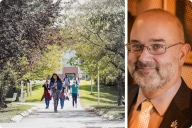You have /5 articles left.
Sign up for a free account or log in.

BulentBARIS/istock/getty images plus
As college and university instructors reflect on pandemic teaching, they probably feel they’ve learned many lessons through the hardship, the struggles and, often, the burnout. Some people speculate that teaching practices will eventually revert back to pre-pandemic approaches, given the “slow-moving and deliberative traditions of higher education.” But other academics are more optimistic, as generally accepted teaching practices have been called into question and instructors may be more likely to draw on the innovative teaching approaches and skills they are developing through remote and hybrid/HyFlex teaching.
As a department chair noted in a 2020 research study that Ralph A. Gigliotti conducted, some see this collective experience of pandemic teaching as “a timely opportunity to push all of us to more effectively orient ourselves to what we should have been doing all along (e.g., more active learning, experiential learning, greater use of backward design, flipped classrooms, greater intentionality, etc.).” We agree that this is a time to embrace innovation. In this moment, we can build on the fact that faculty attitudes toward students and teaching are shifting and bury the dead ideas that continue to linger in teaching and learning. The “Dead Ideas in Teaching and Learning” podcast, produced by the Columbia University Center for Teaching and Learning, where we work, highlights a number of those ideas—such as that faculty are the only experts in a classroom. So does a previous article we wrote for Inside Higher Ed.
Department chairs can play an especially important role in questioning old approaches to teaching and learning and putting new ones on the agenda. As “the most influential scholar/administrator,” a chair can foster change in their department and institution because of the way they can bring people together and connect with faculty and students. Even as the uncertainty continues and department chairs still often operate in a crisis leadership mode, chairs can capitalize on recent innovations to teaching and learning practices as well as existing efforts within their department. With heightened attention to the role of the department chair engendered by the Netflix series The Chair, their continued commitment to “reimagining, re-envisioning and reinventing,” in the words of University of Maryland chair Amanda Bailey, will not go unnoticed.
So how specifically can chairs help sustain the transformations in pedagogical approaches that have burgeoned during the pandemic? How can they keep building on the lessons we are learning from remote teaching and combine them with what departments are already doing to support teaching? We offer five suggestions for chairs.
- Make space and take time to talk about teaching. Set aside time in department meetings to intentionally discuss teaching. Whether once a term to debrief, once a month to celebrate scholarly teaching efforts and share teaching innovations, or more frequently to brainstorm solutions to common teaching challenges, building these conversations into existing structure amplifies the value that the department and institution place on teaching. Time is our most scarce resource, so that can be hard to do. But a chair who makes space for such conversations helps ensure that teaching in higher education will no longer “remain an amateurish enterprise and an individual endeavor,” as Steven Mintz, professor of history at the University of Texas at Austin (and an Inside Higher Ed blogger), put it.
- Encourage community around teaching. After months of feeling the isolation of remote life, many people are craving community. Beyond embedding conversations about teaching into department meetings, chairs can encourage faculty members to come together to discuss their teaching and connect informally in smaller groups both within and across departments. Such groups may open up their classrooms, whether in person or virtual, to one another—observing each other’s courses and finding inspiration by seeing their teaching and learning in action. They can also explore how they might draw on their colleagues’ strategies for creating inclusive and antiracist learning environments, engaging all learners, and implementing innovative approaches to assessing student learning.
- Recognize teaching efforts. As we all know, recognition of teaching goes beyond universitywide teaching awards. It can be acknowledging the scholarly teaching efforts taking place in the department, inviting colleagues to present their approaches over lunch or highlighting good practices in departmental, school or institutional communications. Encouraging faculty members to present their scholarly teaching efforts beyond your department brings greater visibility to the teaching and learning taking place within it. At the Columbia Center for Teaching and Learning, some of the ways we bring visibility to the creativity of our faculty include partnering on faculty spotlights and asking our faculty to share their teaching efforts during our annual Celebration of Teaching and Learning Symposium.
- Invite students into conversations about teaching and learning. Department chairs hear from students on a regular basis, and student perspectives are extremely valuable in conversations about teaching and learning. At the center, we’ve seen that firsthand through our Students as Pedagogical Partners initiative, in which students work with faculty to co-create learner-centered and inclusive classrooms. Many instructors are also actively seeking feedback from their students during the pandemic—listening to their concerns and learning challenges, and adapting their courses to meet students where they are. This is intense work, however, and sustaining such efforts will require adjusting teaching practices and priorities. By encouraging those types of connections with students, chairs can help ensure such partnerships will continue.
Consider urging your faculty to speak informally with their students about how their courses are going and to collect informal student feedback throughout the semester. (See our center’s Early and Mid-Semester Student Feedback resource for ideas on how to do this.) Why wait until end-of-term course evaluations to hear the student voices? Also, departments often organize student panels for prospective majors, so if you’re looking for a way to help facilitate a faculty-student conversation about teaching, consider organizing one for the faculty to hear the students’ perspectives and engage in conversations about teaching and learning within the discipline.
- Partner with your center for teaching and learning (or another campus entity that can support instructors to enhance teaching and learning). Draw on the teaching resources that exist on your campus and help your colleagues to save time, find community and re-energize their teaching. Encourage faculty members to participate in your center’s offerings or partner with it to offer a customized session for your program, department or school. Centers like ours are here to help, and you need not do this important work on your own.
Although teaching through a pandemic continues to be stressful and challenging, instructors have also found certain aspects to be freeing. They have sought creative solutions, learned new skills, experimented with new pedagogical strategies and taken risks unlike they ever have before. At our center, we’ve heard that from the faculty whom we work with, and many have shared with us how they adapted to new teaching modalities through our Voices of Hybrid and Online Teaching and Learning initiative. They’ve also innovated to meet students where they are within their teaching contexts, as documented through the 2021 Celebration of Teaching and Learning Symposium.
Those of us who work in centers for teaching continue to encourage faculty to reflect back in order to reflect forward—to take a pause that allows them to use what they have learned in the past to inform future practices. We also remind them to take time to care for themselves as they teach through times of stress and challenge. Conducting this important work and sustaining changes to teaching and learning is a community effort. We call on chairs to put teaching on the agenda, but we are not asking you to do it alone. We’re here to partner with you in whatever capacity makes sense for your department.








